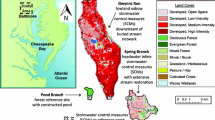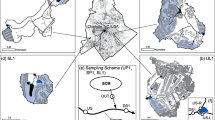Abstract
Urbanization alters watershed ecosystem functioning, including nutrient budgets and processes of nutrient retention. It is unknown, however, how variation in stormwater infrastructure design affects the delivery of water and materials from urban watersheds. In this study, we asked: (1) How does stormwater infrastructure design vary over time and space in an arid city (Phoenix, Arizona, USA)?, and (2) How does variation in infrastructure design affect fluxes of dissolved nitrogen (N), phosphorus (P), and organic carbon (DOC) from urban watershed ecosystems? From 1955 to 2010, stormwater infrastructure designs shifted from pipes, to engineered channels and retention basins, to natural washes. We monitored 10 nested watersheds, where small (5–141 ha) watersheds had medium-density residential land use but differed in stormwater infrastructure, whereas larger watersheds (1,662–20,247 ha) had a variety of land uses and infrastructures. We measured rainfall in each watershed and discharge and dissolved N, P, and DOC concentrations in flow at each watershed outlet for runoff-generating rainfall events between 2010 and 2012. We used path analysis to test hypotheses about the relationships among infrastructure characteristics, land cover, storm characteristics (including antecedent conditions), and nutrient and DOC loads. We found that retention-basin density decreased and imperviousness increased runoff, which in turn increased nutrient and DOC delivery. Concentrations varied with antecedent conditions and rainfall but did not vary with watershed characteristics. We show that stormwater infrastructure creates heterogeneity in the hydrologic and biogeochemical function of urban watersheds and that stormwater management may represent a major source of ecosystem heterogeneity within and across cities.




Similar content being viewed by others
References
Arnold CL, Gibbons CJ. 1996. Impervious surface coverage: the emergence of a key environmental indicator. J Am Plann Assoc 62:243–58.
Austin A, Yahdjian L, Stark J, Belnap J, Porporato A, Norton U, Ravetta D, Schaeffer S. 2004. Water pulses and biogeochemical cycles in arid and semiarid ecosystems. Oecologia 141:221–35.
Belnap J, Welter JR, Grimm NB, Barger N, Ludwig JA. 2005. Linkages between microbial and hydrologic processes in arid and semiarid watersheds. Ecology 86:298–307.
Bettez ND, Groffman PM. 2012. Denitrification potential in stormwater control structures and natural riparian zones in an urban landscape. Environ Sci Technol 46:10909–17.
Booth D, Jackson C. 1997. Urbanization of aquatic systems: Degradation thresholds, stormwater detection, and the limits of mitigation. J Am Water Resour Assoc 33:1077–90.
Brabec E, Schulte S, Richards PL. 2002. Impervious surfaces and water quality: a review of current literature and its implications for watershed planning. J Plan Lit 16:499–514.
Burian SJ, Nix SJ, Pitt RE, Durrans SR. 2000. Urban wastewater management in the United States: past, present, and future. J Urban Technol 7:33–62.
Cadenasso ML, Pickett STA, Schwarz K. 2007. Spatial heterogeneity in urban ecosystems: reconceptualizing land cover and a framework for classification. Front Ecol Environ 5:80–8.
Chocat B, Krebs P, Marsalek J, Rauch W, Schilling W. 2001. Urban drainage redefined: from stormwater removal to integrated management. Water Sci Technol 43:61–8.
Delleur JW. 2003. The evolution of urban hydrology: past, present, and future. J Hydraul Eng 129:563–73.
Dunne T, Leopold LB. 1978. Water in environmental planning. New York: Macmillan.
Ellis J, Marsalek J. 1996. Overview of urban drainage: environmental impacts and concerns, means of mitigation and implementation policies. J Hydraul Res 34:723–31.
Elmore AJ, Kaushal SS. 2008. Disappearing headwaters: patterns of stream burial due to urbanization. Front Ecol Environ 6:308–12.
Flood Control District of Maricopa County. 2007. Drainage policies and standards for Maricopa County, Arizona.
Flood Control District of Maricopa County. 2013. Drainage design manual for Maricopa County, Arizona: Hydrology, 4th Ed.
Gallo EL, Brooks PD, Lohse KA, McLain JET. 2013a. Land cover controls on summer discharge and runoff solution chemistry of semi-arid urban catchments. J Hydrol 485:37–53.
Gallo EL, Brooks PD, Lohse KA, McLain JET. 2013b. Temporal patterns and controls on runoff magnitude and solution chemistry of urban catchments in the semiarid southwestern United States. Hydrol Process 27:995–1010.
Gallo EL, Lohse KA, Brooks PD, McIntosh JC, Meixner T, McLain JET. 2012. Quantifying the effects of stream channels on storm water quality in a semi-arid urban environment. J Hydrol 470:98–110.
Grimm NB, Foster D, Groffman P, Grove JM, Hopkinson CS, Nadelhoffer KJ, Pataki DE, Peters DP. 2008. The changing landscape: ecosystem responses to urbanization and pollution across climatic and societal gradients. Front Ecol Environ 6:264–72.
Grimm NB, Sheibley RW, Crenshaw CL, Dahm CN, Roach WJ, Zeglin LH. 2005. N retention and transformation in urban streams. J North Am Benthol Soc 24:626–42.
Groffman PM, Bain DJ, Band LE, Belt KT, Brush GS, Grove JM, Pouyat RV, Yesilonis IC, Zipperer WC. 2003. Down by the riverside: urban riparian ecology. Front Ecol Environ 1:315–21.
Groffman PM, Cavender-Bares J, Bettez ND, Grove JM, Hall SJ, Heffernan JB, Hobbie SE, Larson KL, Morse JL, Neill C, Nelson K, O’Neil-Dunne J, Ogden L, Pataki DE, Polsky C, Chowdhury RR, Steele MK. 2014. Ecological homogenization of urban USA. Front Ecol Environ 12:74–81.
Groffman PM, Law NL, Belt KT, Band LE, Fisher GT. 2004. Nitrogen fluxes and retention in urban watershed ecosystems. Ecosystems 7:393–403.
Hall S, Ahmed B, Ortiz P, Davies R, Sponseller R, Grimm N. 2009. Urbanization alters soil microbial functioning in the Sonoran Desert. Ecosystems 12:654–71.
Hatt BE, Fletcher TD, Walsh CJ, Taylor SL. 2004. The influence of urban density and drainage infrastructure on the concentrations and loads of pollutants in small streams. Environ Manage 34:112–24.
Hu L, Bentler PM. 1999. Cutoff criteria for fit indexes in covariance structure analysis: conventional criteria versus new alternatives. Struct Equ Model Multidiscip J 6:1–55.
Jacobson CR. 2011. Identification and quantification of the hydrological impacts of imperviousness in urban catchments: a review. J Environ Manage 92:1438–48.
Kaushal S, Belt K. 2012. The urban watershed continuum: evolving spatial and temporal dimensions. Urban Ecosyst 15:409–35.
Kaushal S, Groffman P, Band L, Shields C, Morgan R, Palmer M, Belt K, Swan C, Findlay S, Fisher G. 2008. Interaction between urbanization and climate variability amplifies watershed nitrate export in Maryland. Environ Sci Technol 42:5872–8.
Keys E, Wentz EA, Redman CL. 2007. The spatial structure of land use from 1970–2000 in the Phoenix, Arizona, Metropolitan Area. Prof Geogr 59:131–47.
Kline RB. 2010. Principles and practice of structural equation modeling. 3rd edn. New York: The Guilford Press.
Larson EK, Grimm NB, Gober P, Redman CL. 2005. The paradoxical ecology and management of water in the Phoenix, USA metropolitan area. Ecohydrol Hydrobiol 5:287–96.
Larson EK, Grimm NB. 2012. Small-scale and extensive hydrogeomorphic modification and water redistribution in a desert city and implications for regional nitrogen removal. Urban Ecosyst 15:71–85.
Lee J, Heaney J. 2003. Estimation of urban imperviousness and its impacts on storm water systems. J Water Resour Plan Manage 129:419–26.
Lee JH, Bang KW, Ketchum LH, Choe JS, Yu MJ. 2002. First flush analysis of urban storm runoff. Sci Total Environ 293:163–75.
Lewis D, Grimm N. 2007. Hierarchical regulation of nitrogen export from urban catchments: interactions of storms and landscapes. Ecol Appl 17:2347–64.
Li X, Myint SW, Zhang Y, Galletti C, Zhang X, Turner BLII. 2014. Object-based land-cover classification for metropolitan Phoenix, Arizona, using aerial photography. Int J Appl Earth Obs Geoinf 33:321–30.
Lohse K, Hope D, Sponseller R, Allen J, Grimm N. 2008. Atmospheric deposition of carbon and nutrients across an and metropolitan area. Sci Total Environ 402:95–105.
Meierdiercks KL, Smith JA, Baeck ML, Miller AJ. 2010. Heterogeneity of hydrologic response in urban watersheds. J Am Water Resour As 46:1221–37.
Melosi MV. 2000. The sanitary city: urban infrastructure in America from colonial times to the present. Baltimore: Johns Hopkins University Press.
Ogden FL, Pradhan NR, Downer CW, Zahner JA. 2011. Relative importance of impervious area, drainage density, width function, and subsurface storm drainage on flood runoff from an urbanized catchment. Water Resour Res 47:W12503.
Osterkamp WR, Friedman JM. 2000. The disparity between extreme rainfall events and rare floods: with emphasis on the semi-arid American West. Hydrol Process 14:2817–29.
Paul MJ, Meyer JL. 2001. Streams in the urban landscape. Annu Rev Ecol Syst 32:333–65.
Pitt R, Clark S. 2008. Integrated storm-water management for watershed sustainability. J Irrig Drain Eng-ASCE 134:548–55.
Raciti SM, Burgin AJ, Groffman PM, Lewis DN, Fahey TJ. 2011. Denitrification in Suburban Lawn Soils. J Environ Qual 40:1932–40.
Raciti SM, Groffman PM, Fahey TJ. 2008. Nitrogen retention in urban lawns and forests. Ecol Appl 18:1615–26.
Roach WJ, Heffernan JB, Grimm NB, Arrowsmith JR, Eisinger C, Eisinger T. 2008. Unintended consequences of urbanization for aquatic ecosystems: a case study from the Arizona Desert. BioScience 58:715–27.
Schueler TR, Fraley-McNeal L, Cappiella K. 2009. Is impervious cover still important? Review of recent research. J Hydrol Eng 14:309–15.
Shuster WD, Bonta J, Thurston H, Warnemuende E, Smith DR. 2005. Impacts of impervious surface on watershed hydrology: a review. Urban Water J 2:263–75.
Sibson R. 1981. A brief description of natural neighbor interpolation. In: Barnett V, Ed. Interpreting multivariate data. Chichester: Wiley. p 21–36.
Steele MK, Heffernan JB, Bettez N, Cavender-Bares J, Groffman PM, Grove JM, Hall S, Hobbie SE, Larson K, Morse JL, Neill C, Nelson KC, O’Neil-Dunne J, Ogden L, Pataki DE, Polsky C, Chowdhury RR. 2014. Convergent Surface Water Distributions in U.S. Cities. Ecosystems:1–13.
Walsh CJ, Fletcher TD, Burns MJ. 2012. Urban stormwater runoff: a new class of environmental flow problem. PLoS One 7(9):e45814.
Walsh CJ, Roy AH, Feminella JW, Cottingham PD, Groffman PM, Morgan RP. 2005. The urban stream syndrome: current knowledge and the search for a cure. J North Am Benthol Soc 24:706–23.
Welter JR, Fisher SG, Grimm NB. 2005. Nitrogen transport and retention in an arid land watershed: influence of storm characteristics on terrestrial–aquatic linkages. Biogeochemistry 76:421–40.
Wollheim WM, Pellerin BA, Vorosmarty CJ, Hopkinson CS. 2005. N retention in urbanizing headwater catchments. Ecosystems 8:871–84.
Wolman MG. 1967. A cycle of sedimentation and erosion in urban river channels. Geogr Ann Ser Phys Geogr 49:385–95.
Zhu WX, Dillard ND, Grimm NB. 2004. Urban nitrogen biogeochemistry: status and processes in green retention basins. Biogeochemistry 71:177–96.
Acknowledgements
We thank the cities of Tempe, Phoenix, and Scottsdale for permission and assistance in stormwater sampling and for providing datasets describing stormwater infrastructure. The Environmental Remote Sensing and Geoinformatics Lab at Arizona State University provided land-cover classification data. This material is based upon the work supported by the National Science Foundation under Grant numbers BCS-1026865 (CAP LTER) and DEB-0918457 (Impacts of urbanization on nitrogen biogeochemistry in xeric ecosystems). Hale received additional funding from National Science Foundation Grant number No. 0504248, IGERT in Urban Ecology at Arizona State University. Kate Lindekugel, Cathy Kochert, Quincy Stewart, Nicholas Weller, Sarah Moratto, and Danielle Shorts provided valuable field and lab assistance.
Author information
Authors and Affiliations
Corresponding author
Additional information
Authors Contribution
RLH conceived of or designed the study, performed research, analyzed data, and wrote the paper; LT conceived of or designed the study, performed research, analyzed data, and wrote the paper; the paper SRE conceived of or designed the study, performed research, and wrote the paper; DLC conceived of or designed the study and wrote the paper; NBG conceived of or designed the study, analyzed data, and wrote the paper.
Electronic supplementary material
Below is the link to the electronic supplementary material.
Rights and permissions
About this article
Cite this article
Hale, R.L., Turnbull, L., Earl, S.R. et al. Stormwater Infrastructure Controls Runoff and Dissolved Material Export from Arid Urban Watersheds. Ecosystems 18, 62–75 (2015). https://doi.org/10.1007/s10021-014-9812-2
Received:
Accepted:
Published:
Issue Date:
DOI: https://doi.org/10.1007/s10021-014-9812-2




